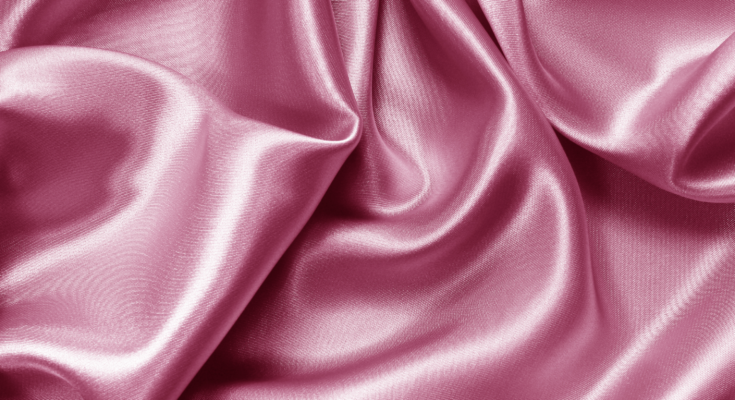Disclosure: This post may contain affiliate links. I earn a small commission when you click a link and make a purchase. Thanks for supporting SewingSociety.com!
Satin is a smooth, woven fabric with floats of yarn in the warp that make it shine. It is typically made from silk but is also available in synthetics. Satin fabric is a popular choice for special occasion dresses, choir robes, and theater costumes.
Crepe-back satin is a reversible fabric with a shiny satin side and a matching, textured crepe on the reverse side. It can be used within the same garment for a beautiful contrast between shiny and matte surfaces.
Preparation and Care of Satin
Satin is prone to snags because of the floats of thread over its surface. Therefore, handwashing is the safest method for avoiding damage to your fabric. If you must wash it, put satin on a delicate cycle and use a gentle detergent, such as The Laundress. If your satin does snag, a loose thread can sometimes be put back in place by carefully stroking the pulled thread back into the fabric with the end of a pin.
Press satin with a press cloth barrier to avoid marking or scorching it. A seam roll is also helpful for pressing seams open. If you sew with a lot of delicate fabrics, a steamer is a good investment for quickly smoothing wrinkles from fabric.
Layout, Marking, and Cutting Tips for Satin
Because it can be hard to tell the right side of the fabric from the wrong side (unless it is crepe-back satin), be sure to mark the right side somehow. Also, fold the fabric and straighten the ends before cutting. If the fabric layers slip on your cutting table, lay your fabric over a layer of tissue paper first.
Satin tends to show pin and needle marks, so use pattern weights or be careful to pin only in the seam allowances. Also, transfer pattern markings to the wrong side of your fabric using tailor’s chalk (which disappears when pressed) or a dressmaker’s pencil or marker. Cut with sharp shears to avoid snags.
Avoid wash-out notions with satin unless your fabric is washable. Also, use sew-in interfacing to avoid the hotter iron temperatures needed for fusible interfacing. Be sure any linings and notions will take the same cleaning process as your fashion fabric.
Sewing Machine Setup for Satin
Satin seams tend to pucker if your tension is not set just right. Therefore, test your seams on some scraps of fabric before beginning a project.
- Needle: Use a jeans/sharp needle. A size 80/12 or 90/14 needle works well for most satins. You want something very sharp to avoid snags, so always start satin projects with a new needle.
- Presser Foot: A straight stitch foot or zigzag foot may be used.
- Stitch Length/Width: Set your stitch length between 3.0mm and 4.0mm.
Sewing Tips for Satin
If you are making several items from the same fabric, such as for bridesmaids or a choir, cut them all out at the same time to be sure they are all cut from the same side of the fabric. If the right and wrong sides get confused, some dresses may appear to be of a slightly different color. Also, be sure of fit before sewing satin because if a seam needs to be let out, the needle holes from the old seam might show, even with careful steaming.
Also, keep in mind that satin will fray if the raw edges are not finished with a serger or zigzag stitch.
What sewing projects have you made with satin? Do you have any tips to add? Let us know in the comments below!
Share this post on Pinterest!






One Comment on “Tips for Sewing Satin Fabric”